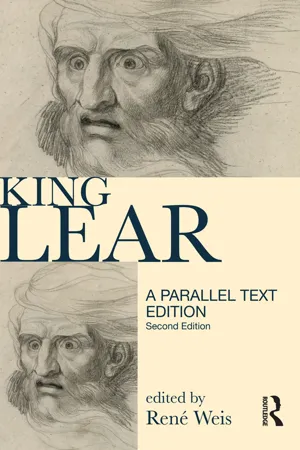![]()
THE TEXTS
![]()
The History of King Lear (Q: 1608)
[DRAMATIS PERSONAE
LEAR, King of Britain
GONERIL, Lear’s eldest daughter
REGAN, Lear’s second daughter
CORDELIA, Lear’s youngest daughter
Duke of ALBANY, Goneril’s husband
Duke of CORNWALL, Regan’s husband
King of FRANCE, Cordelia’s husband
Duke of BURGUNDY, suitor of Cordelia
Earl of KENT, later disguised as Caius
Earl of GLOUCESTER
EDGAR, elder son of Gloucester, later disguised as Poor Tom
EDMUND, bastard son of Gloucester
OLD MAN, a tenant of Gloucester
CURAN, a retainer of Gloucester
Lear’s FOOL
OSWALD, Goneril’s steward
GENTLEMAN, attendant on Cordelia
DOCTOR
THREE SERVANTS of Cornwall
HERALD
THREE CAPTAINS
SERVANT
KNIGHT
MESSENGER
Knights of Lear’s train, Attendants, Soldiers, Trumpeters, Others]
![]()
The Tragedy of King Lear (F: 1623)
[DRAMATIS PERSONAE
LEAR, King of Britain
GONERIL, Lear’s eldest daughter
REGAN, Lear’s second daughter
CORDELIA, Lear’s youngest daughter
Duke of ALBANY, Goneril’s husband
Duke of CORNWALL, Regan’s husband
King of FRANCE, Cordelia’s husband
Duke of BURGUNDY, suitor of Cordelia
Earl of KENT, later disguised as Caius
Earl of GLOUCESTER
EDGAR, elder son of Gloucester, later disguised as Poor Tom
EDMUND, bastard son of Gloucester
OLD MAN, a tenant of Gloucester
CURAN, a retainer of Gloucester
Lear’s FOOL
OSWALD, Goneril’s steward
GENTLEMAN, attendant on Cordelia
A SERVANT of Cornwall
HERALD
Two CAPTAINS
SERVANT
KNIGHT
TWO MESSENGERS
Knights of Lear’s train, Attendants, Soldiers, Trumpeters, Others]
![]()
[Act 1 Scene 1]
Enter Kent, Gloucester, and Edmund
Kent I thought the King had more affected the Duke of Albany than Cornwall.
Gloucester It did always seem so to us, but now in the division of the kingdoms, it appears not which of the dukes he values most, for equalities are so weighed that [5] curiosity in neither can make choice of either’s moiety.
Kent Is not this your son, my lord?
Gloucester His breeding, sir, hath been at my charge. I have so often blushed to acknowledge him that now I am brazed to it. 10
Kent I cannot conceive you.
Gloucester Sir, this young fellow’s mother could, whereupon she grew round-wombed and had indeed, sir, a son for her cradle ere she had a husband for her bed. Do you smell a fault? 15
Kent I cannot wish the fault undone, the issue of it being so proper.
Gloucester But I have, sir, a son by order of law, some year elder than this, who yet is no dearer in my account. Though this knave came something saucily into the world [20] before he was sent for, yet was his mother fair; there was good sport at his making, and the whoreson must be acknowledged. Do you know this noble gentleman, Edmund?
Edmund No, my lord. 25
Gloucester My lord of Kent. Remember him hereafter as my honourable friend.
Edmund My services to your lordship.
Kent I must love you, and sue to know you better.
Edmund Sir, I shall study deserving. 30
Gloucester He hath been out nine years, and away he shall again. The King is coming.
Sound a sennet. Enter one bearing a coronet, then Lear, then the Dukes of Albany and Cornwall; next Goneril, Regan, Cordelia, with Followers
Lear Attend my lords of France and Burgundy, Gloucester.
Gloucester I shall, my liege. [Exit]
Lear Meantime we will express our darker purposes. 35
The map there. Know we have divided
In three our kingdom, and ’tis our first intent
To shake all cares and business of our state,
Confirming them on younger years.
The two great princes, France and Burgundy, 40
Great rivals in our youngest daughter’s love,
Long in our court have made their amorous sojourn,
And here are to be answered. Tell me, my daughters,
Which of you shall we say doth love us most,
That we our largest bounty may extend 45
Where merit doth most challenge it?
Goneril, our eldest born, speak first.
Goneril Sir, I do love you more than words can wield the matter,
Dearer than eyesight, space, or liberty,
Beyond what can be valued rich or rare; 50
No less than life, with grace, health, beauty, honour;
As much as child e’er loved, or father, friend;
A love that makes breath poor and speech unable.
Beyond all manner of so much I love you.
Cordelia [aside] What shall Cordelia do? Love and be silent. 55
Lear Of all these bounds, even from this line to this,
With shady forests and wide-skirted meads,
We make thee lady. To thine and Albany’s issue
Be this perpetual. What says our second daughter,
Our dearest Regan, wife to Cornwall? Speak. 60
Regan Sir, I am made
Of the self-same metal that my sister is,
And prize me at her worth in my true heart.
I find she names my very deed of love;
Only she came short: that I profess 65
Myself an enemy to all other joys
Which the most precious square of sense possesses,
And find I am alone felicitate
In your dear highness’ love.
Cordelia [aside] Then poor Cordelia!
And yet not so, since I am sure my love’s 70
More richer than my tongue.
Lear To thee and thine hereditary ever
Remain this ample third of our fair kingdom;
No less in space, validity, and pleasure
Than that confirmed on Goneril. But now, our joy, 75
Although the last, not least in our dear love,
What can you say to wi...



